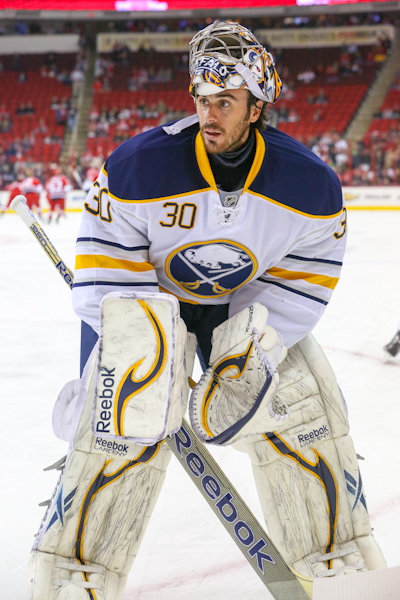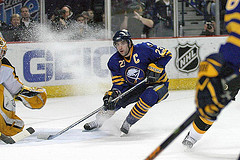If you’re a Buffalo Sabres fan, things are looking up.
Jack Eichel is proving that he has what it takes to be the team’s franchise player. Rasmus Ristolainen is emerging as a Norris Trophy-caliber defenseman. Forwards such as Sam Reinhart, Ryan O’Reilly, and Kyle Okposo are also consistently producing.
The team has what it takes to be an actual contender a couple of years from now, which is something they haven’t been in years. Ten years, to be exact.
The 2016-17 NHL season is the ten-year anniversary of the Buffalo Sabres’ 2006-07 Presidents’ Trophy-winning team, which is arguably the strongest team in the club’s history. Centers Daniel Briere and Chris Drury were the 1-2 punch down the middle that the team had been lacking for some time. Brian Campbell and Teppo Numminen led the team from the blue line. Young players such as Thomas Vanek and Jason Pominville had breakout years, proving that they would be solid players for the Sabres in the years to come.
Coming off of a surprise run to the Eastern Conference Final the year before, the Buffalo Sabres had the potential to do some damage in the 2006-07 season, as well as the following years. Then it all fell apart.
A Record-Breaking Season
Fans knew they were in for something special when the team did not lose a game in regulation during the month of October, getting off to a 10-0-1 start. The Sabres tied a league record by getting off to a 10-0-0 start, and didn’t lose a game in regulation until Nov. 4.

Ryan Miller was beginning to break out as one of the league’s more talented young goaltenders throughout the start of the 2006-07 season. The Michigan State graduate had led the team to the Eastern Conference Final the year before, but hadn’t yet established himself as an elite goaltender in the NHL. That quickly changed in the 2006-07 season, as the then-26-year-old got off to a 9-1-1 start before missing six consecutive games with an injury. Miller returned stronger than ever, and eventually earned himself a place in the NHL All-Star Game.
Ryan Miller wasn’t the only Buffalo Sabre to make the NHL All-Star Game that year. In fact, a total of four Sabres made the Eastern Conference squad that year, including head coach Lindy Ruff. Defenseman Brian Campbell and forward Daniel Briere also made the trip to Dallas that year, the latter of whom actually won the game’s MVP award with one goal and four assists. The then 23-year-old Thomas Vanek also participated in that year’s All-Star Game festivities, as he played in the NHL YoungStars game.
The team was already well on its way to the Presidents’ Trophy by the time the All-Star Break rolled around, sitting at a record of 33-12-4 before the game took place. Buffalo finished strong, losing just three games in the month of February and eventually finishing with a record of 53-22-7. The Sabres finished with 113 points, winning the team’s first (and thus far, only) Presidents’ Trophy as the best team in the regular season.
The Sabres had six 20-goal scorers in the 2006-07 season, something that the team has not had since. Daniel Briere finished 10th in the league in scoring, finishing the campaign with 32 goals and 63 assists for 95 points. Thomas Vanek emerged as an elite goal scorer, finishing the season with 43 goals at just 23 years old. Chris Drury and Jason Pominville both finished with over 30 goals and 60 points, with Derek Roy and Maxim Afinogenov also finishing with over 60 points.
The 2006-07 Buffalo Sabres were, statistically, the best team in the league, and looked to be in a great position to bring the Stanley Cup to Buffalo.
The Beginning of the End
Finishing as the best team in the league, the Sabres earned home-ice advantage throughout the playoffs, something that paid off early. Buffalo defeated the eighth-place New York Islanders in the first round of the 2006-07 playoffs in five games, finishing off the series at HSBC Arena.
Buffalo continued their tour of New York in the next round of the playoffs when the team faced the New York Rangers in the Eastern Conference semi-finals. Although the team won the series in six games, the cracks in the once rock-solid team began to show. Five out of the series’ six games were one-goal games, with the series actually being tied at one point.

The team was just four wins away from making the Stanley Cup Finals for the first time since the 1998-99 season, but one team stood in its way, and that team was perhaps the club Buffalo feared the most. The Sabres were forced to play against the Ottawa Senators in the Eastern Conference Final, one of the few teams Buffalo had a losing record against in the regular season (losing six games to the Sens while only winning three).
Buffalo never had a chance against Ottawa, as the team was handled by the club from Canada’s capital. The Sabres lost the series in five games, never really looking like a Presidents’ Trophy winning team.
Just like that, the season was over. What was perhaps the team’s best shot at winning the Stanley Cup was eliminated before the team even had the chance to play for it. Fans were optimistic, however. Fans felt as though the team would come back stronger and more motivated the next season, and claim the elusive trophy that the team had failed to win throughout their nearly 40-year history.
Boy, were they wrong.
Falling Apart
The 2007 offseason will forever go down as one of the worst in Buffalo Sabres’ history.
Fans thought that the team would be able to keep their core group together while adding depth, a formula that would hopefully result in a Stanley Cup victory. Instead of adding, the team subtracted, and subtracted a substantial amount.
On the first day of free agency, the team lost their captain and leading point scorer Daniel Briere, who signed an eight-year, $52 million dollar contract with the Philadelphia Flyers. The next day, the team’s co-captain, Chris Drury, signed with the New York Rangers, the team Buffalo eliminated in the second round of the playoffs.

Perhaps the team’s biggest off-season move was matching the Edmonton Oilers’ offer sheet on restricted free agent Thomas Vanek, giving Vanek a seven-year contract worth $50 million. In hindsight, this proved to be a mistake, as Vanek would never reach his 2006-07 production again.
After years of building a roster that had arguably become the league’s best, the 2006-07 Sabres were destroyed. The team wouldn’t make the playoffs again until the 2009-10 season, and have only made the playoffs twice since the historic 2006-07 campaign.
Too often, fans look back at the 2006-07 season with the thought of “what could have been,” but fans should start looking back at the team with the thought of “what was.” The team was consistently entertaining to watch, and they captured the heart and imagination of a city with so much love to give.
The 2006-07 Buffalo Sabres is perhaps the best roster the Sabres have ever assembled, and it’s a shame that fans of the blue and gold only got to see that group of players perform at their peak for one season. Thankfully, the roster the team has assembled now has the potential to develop into an elite team, a team that has the potential to put together a season similar to that of the 2006-07 Sabres a couple of years from now. Who knows? Maybe ten years from now, someone will be writing an article about how the 2016-17 Buffalo Sabres were the start of something special.